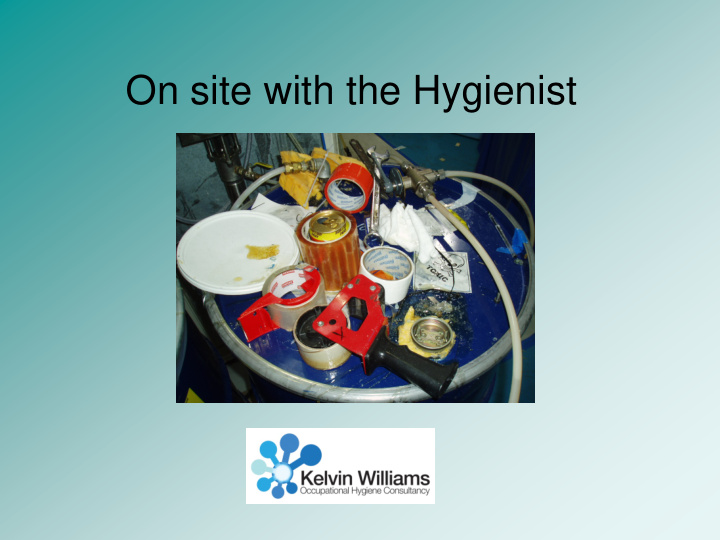



On site with the Hygienist
On site for a day Tall Order! Given – • One day per year may represent about 0.03% of operational time – “you should be here when…”
On site for a day • Man in a white coat with a clipboard – Excess caution on the day (usual) – Excess recklessness on the day (claim conscious worker!) – Effect on results?
On site for a day Pitfalls • Poor research / planning / strategy • Failure to identify hazards / issues (poor dialogue with client) • Over reliance on measurement results • Poor observation skills – No “bedside manner” – Laziness / lack of thoroughness / not inquisitive • Poor interpretation of data • Unhelpful report – client doesn’t know what to do
Consequences of poor survey Context: Soldering • Enforcement authority dissatisfied with previous survey • Report – No mention of technique or job monitored – “ Hygienist ” spent day in local café – Results – all well below WEL – therefore all OK
Consequences of poor survey Re-survey: one day results • One member of staff was 1.5x WEL • Others about 0.5x WEL
Do these measurements matter? Airborne concentration (mg.m -3 )* Analyte P G D B P P cis-1, 2 Dichloroethene - - 0.11 Chloroform 0.02 - 1.95 1,1,1-Trichloroethane 0.04 - 4.93 Carbon tetrachloride - - 0.73 1,2-Dichloroethane 0.006 - 1.67 Trichloroethene 0.007 - 0.84 Toluene 0.017 0.021 1.17 Ethylbenzene - - 0.63 m&p-Xylene 0.024 - 2.33 o-Xylene - - 0.21 Isopentane 0.008 0.005 0.66 Pentane 0.015 0.005 1.67 2-Methyl propanal ** - 3.26 Acetone 0.015 - 1.02 Ethyl acetate - - 1.21 Allyl ether - ** 1.49 3-Carene - - 0.60
On site for a day Reliance on Air Monitoring Results CLIENT – WASTE CONSOLIDATION – “just wanted numbers” No local exhaust ventilation No health surveillance No adequate training No monitoring records (apart from 1 x A4 sheet similar to soldering case study) Inappropriate personal protective equipment (eg domestic Marigold kitchen gloves) Inadequate COSHH assessments “Ah yes! – but the results show we’re OK!”
Client dialogue • What is the problem? • Where is the problem? • What do you do? • What are the hazardous agents involved? (if known – get MSDS or similar) Thoroughly research the above • What is the history / who is concerned? • How many staff do you have? How many are affected? Note: the above two questions are crucial for discerning psycho-social issues / possible industrial relations issues • What is the working pattern? (Busy days / quiet days / worst case days)
On site for a day Making it count • Planning / Identifying hazards and issues • If possible visit site • Walk through the process (include maintenance) • Identify exposed groups • Collect data (including shift times / production schedules / worst case etc) Ask: What can I do that is going to be helpful?
Making measurements that matter
Making measurements that matter
It could be obvious
It could be obvious
Nocebo and Psychosocial factors • Prevalent in office environments (in my experience) • Often vague / non-descript symptoms • Explore history and extent of problem carefully – step back and take broad view • Is there a stress issue? • Lack of job satisfaction? Good literature on the subject
On site for a day DETAILED OBSERVATIONS ARE VITAL!! • Gather as much information as possible – THROUGHOUT THE DAY!! • Take notes, photos, video – make diagrams etc continually! Be curious – don’t be afraid to be a pain. – Working sequence / how does it all work / be alert and questioning / poke around / rummage through the cupboards – Air movement – PPE – Training • Bedside Manner – charm the details out of staff (what happens when you’re not there) • Good questions – draw out staff
On site for a day Be prepared to be thorough • Equipment - smoke tubes, dust lamp (torch), Drager kit (or similar), camera / video, thermometer etc. • Contingency equipment - be prepared to make additional measurements as unforeseen circumstances arise, • Don’t be afraid to be a nuisance, pursue the information you need, • Be inquisitive, get the “whole story”. • Use checklists • Consider and investigate feasibility of control measures while on site
On site for a day TIP WRITE THE REPORT WHILE YOU’RE ON SITE (afarp!) Think!! - could you defend your ideas? If not, what do you need to do, right here and right now, to get the information necessary to qualify your ideas?
Demonstrate problems
Demonstrate Problems
Demonstrate problems
Demonstrate Solutions
Data Interpretation (EN689) • We are normally dealing with an inadequate sample size • Context of survey is a crucial report item eg; – Normal working – Worst case scenario – Quiet day
Statistics - RCS survey Three results Compliant or not? 0.04 mg.m -3 0.03 mg.m -3 0.02 mg.m -3 WEL 0.1 mg.m -3
Report Writing • Give clear helpful advice – You’re being paid to be helpful – Client needs to know what to do • Reflect in-depth research • Provide reasonable caveats • Beware personal bias – Let data / evidence speak – Imagine being in front of a barrister (actually, you might be!)
On site for a day SUMMARY • One day surveys are rarely straightforward and need very careful planning to be of any use • The results of measurements made during one day surveys need careful interpretation in light of a wide range of factors • Measurements that matter are – those that address the real issues (properly researched) – those that are qualified by detailed supporting information and observations • Report must be helpful, with properly supported and clearly listed action points and graphics
Recommend
More recommend